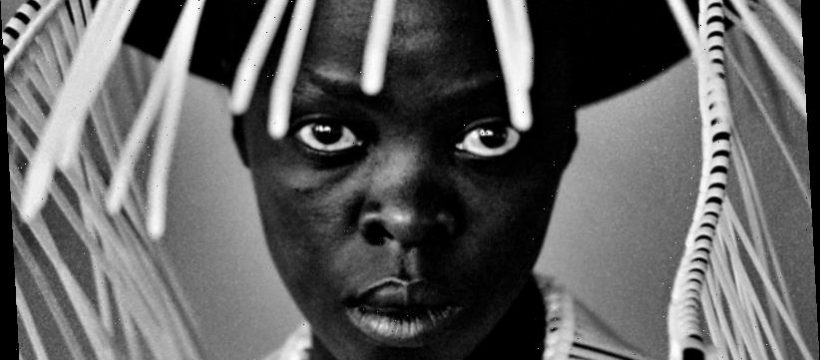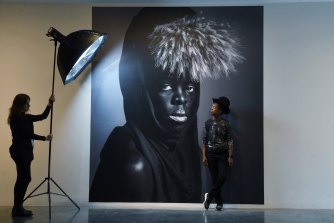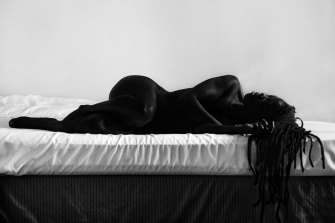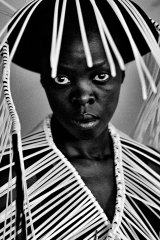In a hotel room somewhere in the world, Zanele Muholi is composing a portrait. Make-up is applied, darkening skin and lightening lids and lips. Everyday objects start to make their way into the picture: a crown of wooden clothes pegs could be paired with a rag-rug cape, a fringe of cable ties draped around shoulders, paper currency might form a makeshift wig, or perhaps a collapsible stool will stand in for a bustier. The subject’s gaze pierces through these accoutrements – accusatory, vulnerable, questioning, fed-up.
The South African visual activist, born under the apartheid regime in 1972, uses photography as their medium to record the black LGBTQI community’s difficult journey towards acceptance in that country. Muholi’s work, on show from today at the Museum of Contemporary Art as part of NIRIN, the 22nd Biennale of Sydney, gives visibility to these people and their stories, exploring the politics of race, gender and sexuality.
Professor Zanele Muholi in front of their work MaID IV, New York, at the MCA.Credit:Nick Moir
“Some of them are activists, some of them are poets, some of them are writers, they are filmmakers, they are photographers, they are many things in our community [and] they then become contributors to the constitution,” Muholi says. “Not everyone gets the chance to write their story, so I think, if given a chance, we have a responsibility as a community to [make] sure that that narrative is out there, and it’s accessible … So each and every person, each and everybody that is featured, that’s that person’s biography … they count as part and parcel of South African democracy”.
While LGBTQI people have equal rights under South Africa’s 1996 post-apartheid constitution (same-sex civil unions were later legalised in 2006), this is not reflected in the reality of everyday life. Black lesbians in particular are frequent targets for hate crimes including murder and “corrective” or “curative” rape. Muholi has documented survivors, funerals, and couples in intimate moments, countering the prevailing narratives of black LGBTQI people as anonymous victims, and in 2006 began a project called Faces and Phases, an ongoing series of more than 500 portraits of LGBTQI people in which participants reappear, and in some tragic cases disappear – a testament to the strengths and vulnerabilities of the community.
The project is an acknowledgement of individuals who are living authentically and who have fought for their freedoms. “[The] participants in Faces and Phases … play different roles in our communities but not everyone … know[s] who they are and what they’ve done for many to gain the sort of freedoms that they are enjoying today. At the time South Africa [legalised] same-sex marriages, there were many voices, there were many bodies at the forefront of that particular movement,” the visual activist says. In the photographs, Muholi captures individuals confronting the viewer with direct gazes.
Zanele Muholi’s Sindile II, Room 206 Fjord Hotel, Berlin, 2017.
Footage of Muholi on set creating Faces and Phases reveals the visual activist styling the hair and outfits of each participant, insisting they look their best to write this chapter of history. Clearly an atmosphere of trust is necessary to create such powerful portraits. “Bearing witness comes with its own challenges. That is really not an easy process … Requesting for people to introduce you to other people, that on its own is challenging … The process starts with one individual … and those individuals introduced me to [others], and then it became a larger project.”
'It is through this documentation that … we get to be respected and recognised in a different way.'
Faces and Phases has been shown in the South African Pavilion at the 55th Venice Biennale in 2013, at Germany's prestigious dOCUMENTA 13 in 2012 and at the 29th Sao Paulo Biennial in 2010. The presentation at the MCA includes around 50 portraits from the acclaimed series taken over the past five years. Muholi credits the participants with the response the work has received internationally, saying that if it weren’t for them, “the world [wouldn’t] even know that LGBTQI people from South Africa exist. It is through this documentation that we get to be seen, in a different way. That we get to be respected and recognised in a different way. So it is through that gesture … and that information [and] knowledge-sharing with different individuals, is how it becomes that concrete document.” NIRIN will also include works from Muholi’s series Brave Beauties, an ongoing body of work featuring trans women, many of whom have won community-based beauty pageants.
As well as a documentary medium, Muholi uses photography “as a therapeutic tool”, highlighted in perhaps their best-known body of work, Somnyama Ngonyama (Zulu for Hail the Dark Lioness). “For the longest time I photographed friends, and friends of friends. And then I was worried that I’d end up losing [myself] along the way. I needed to remember that I was part of that community, so I started focusing on what affected me … my concerns, and many other things that were happening around me.”
Nomalandi Wenda, Parktown, 2016.Credit:Zanele Muholi
In Somnyama Ngonyama, Muholi goes in front of the lens, their body becoming a participant, a material of agency, in their own work. These self portraits have been taken in all sorts of settings as the activist travelled around the world, with all the complexities that entails. “With Somnyama Ngonyama I’m pointing to historical events and also immediate events that are affecting me… crossing borders, going to different spaces, seeing something happening right then … I’ll go back to the hotel room or whatever location I’m staying in, and I’ll take a portrait, in response to that occurrence.”
In many of the artist's arresting images, Muholi uses make-up to exaggerate contrast while transforming everyday objects such as tyres, pegs and rag rugs into elaborate and striking props and costumes that frame the subject’s face. In others, Muholi leaves aside the costumes, instead using their own body, often naked, posed with mirrors or in diptychs to explore multiple viewpoints.
Across the series, Muholi explores the slippages and multiplicities of identity. They also confront head-on Western representations of black bodies through art history, playing with these representations, reclaiming them and turning the gaze assertively back onto the viewer. At the MCA, a selection from the series is presented scaled up as wallpaper, Muholi positioned as a larger-than-life presence in the space.
For Muholi, working in hotel rooms and outdoor settings is a deliberate strategy to streamline their artistic practice. “I turn different places into my own studio, it could be a kitchen, a bedroom, under a bridge, anywhere, so as long as it’s a space that I want to work. I don’t need much equipment to produce.
"Right now I try to keep it simple, and also use methods to decolonise photography.” They are aware of the often prohibitive cost that limits access to contemporary photography for many people. “To come up with simpler approaches to it means [moving in] a fairer direction.”
They also confront head-on Western representations of black bodies through art history.
The artist states: "I am producing this photographic document to encourage people to be brave enough to occupy space, brave enough to create without fear of being vilified … To teach people about our history, to rethink what history is all about, to reclaim it for ourselves, to encourage people to use artistic tools such as cameras as weapons to fight back."
Accessibility and affordability are not the only approaches to sharing works as widely as possible. Participants in their projects have previously been invited to attend and contribute to exhibitions, including writing statements directly on the gallery walls. “To share the responses of other people is [also] very important. That means that it’s no longer mine. Once it’s out there in the open, a lot of people engage with it and it is through that engagement that people learn about our country.”
Muholi takes this quest for engagement a step further through Inkanyiso, a media website in which participants in the Faces and Phases series tell their own stories, and those of their community, free of the constraints of the mainstream press. Launched in 2006, Inkanyiso now features stories on everything from pap tests to pride parades. The shared experiences of hate and fear become what the activist has previously called “a binding factor for the LGBTQI community”.
Zanele Muholi, Bhekezakhe, Parktown, 2016.
While in Sydney for the Biennale, the activist has plans to work with local queer and trans groups. “We want to share narrative in ways that have never been done before, speaking of possible collaborations and connections, which helps us to expand all that is happening in our movement.”
NIRIN artistic director Brook Andrew believes that “Muholi is important because of their role as activator within communities. I'm really interested in their community activation, in which [they go] into the community and give people cameras, [reversing] the idea of voyeurism around women's bodies, black bodies, so people are actually self-representing, and taking control of themselves, their own queerness, their own sexual identity.
"This self-representation and self-love also upends the ethnographic and voyeuristic history of documenting people of colour and diaspora through the colonial machine and legacy, and I think that absolutely needs to be redirected through self-representation and power.” Works from Somnyama Ngonyama will also be exhibited in Melbourne where Muholi will speak on Thursday as part of the PHOTO 2020 International Festival of Photography.
Despite the extremely variable conditions under which they are made, Muholi’s photographs are technically accomplished and aesthetically exquisite, a testament to their commitment to their craft, which began with training at the Market Photo Workshop in Johannesburg (a progressive institution founded by renowned photographer David Goldblatt). In 2013 they became an Honorary Professor at the University of the Arts, Bremen. Somnyama Ngonyama has been exhibited across South Africa, the US and Europe, and a major career survey exhibition will open in late April at the Tate Modern, London.
It is apparent that visual activism is the driving element of their practice, and that these accolades are secondary to documenting the history and sharing the stories of black LGBTQI people in South Africa. “People need to be heard and recognised. Their stories are important, their lives are important,” Muholi says. “Black people, specifically, are there, but we don’t get to read much about their lives, and what affects them as well. So, to see them in front of us, recognising and respecting them, I think is key. To say that we see you, we respect you, and that your voice shall be heard.”
Zanele Muholi's work is at the MCA as part of the 22nd Biennale of Sydney: NIRIN until June 8.
Source: Read Full Article




